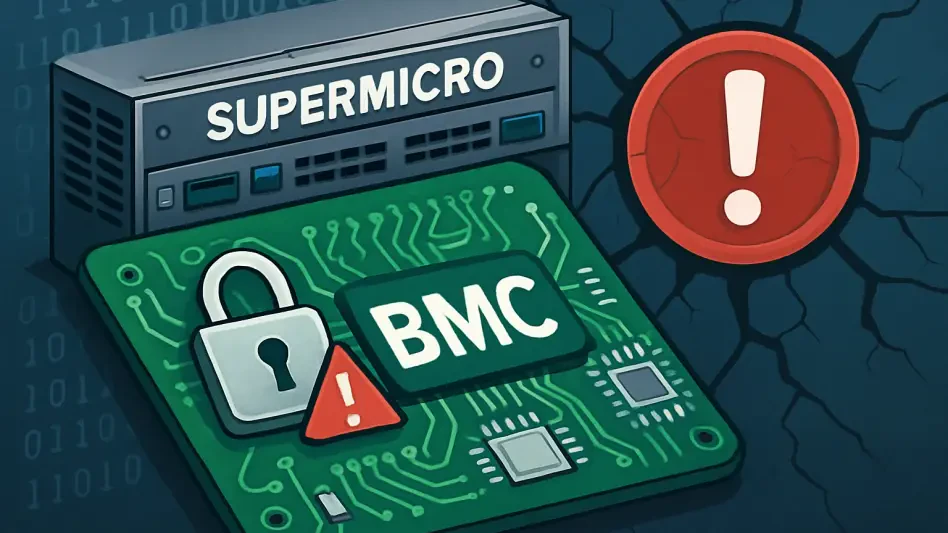In the ever-evolving landscape of cybersecurity, a startling discovery has shaken the foundation of enterprise server infrastructure, revealing critical vulnerabilities in the Baseboard Management Controller (BMC) firmware of Supermicro motherboards. These flaws, which allow attackers to bypass essential security mechanisms, pose a severe threat to data centers and high-stakes environments that rely on robust hardware integrity. As businesses increasingly depend on secure server systems to protect sensitive data and ensure operational continuity, the emergence of such systemic issues raises urgent questions about the safety of widely used hardware. This alarming situation underscores the need for a deeper examination of firmware validation processes and the effectiveness of vendor responses in addressing these pervasive risks. The implications of these vulnerabilities extend far beyond isolated incidents, pointing to broader challenges in securing critical infrastructure against sophisticated cyber threats.
Uncovering the Vulnerabilities in BMC Firmware
Exploring the Nature of the Flaws
The core of the issue lies in fundamental design weaknesses within the BMC firmware validation process of Supermicro hardware, which attackers exploit to gain unauthorized access and control. Specifically, vulnerabilities such as CVE-2024-10237, CVE-2025-7937, and CVE-2025-6198 highlight a troubling pattern of inadequate security measures. These flaws enable malicious actors to bypass signature verification mechanisms by manipulating firmware region tables and embedding harmful code without triggering security alerts. Such exploits undermine the BMC Root of Trust (RoT), a critical feature meant to ensure hardware integrity. The ability to upload malicious firmware updates represents a significant breach of trust in systems that form the backbone of enterprise environments. This situation is compounded by the fact that these issues span multiple generations of hardware, suggesting a systemic problem rather than isolated errors. The persistent nature of these vulnerabilities demands a reevaluation of how firmware security is approached in server design.
Impact of Persistent Design Weaknesses
Beyond the technical details, the broader impact of these design weaknesses reveals a critical risk to enterprise infrastructure that cannot be ignored. Attackers exploiting these BMC firmware flaws can achieve persistent control over servers, extending their influence to the main operating systems and compromising entire networks. This escalation pathway poses a dire threat to data centers, where a single breach can lead to catastrophic data loss or operational downtime. Research has shown that even basic exploitation techniques, such as manipulating validation sequences during boot processes, can dismantle security models with alarming ease. The recurring failure to address underlying authentication issues in firmware design perpetuates a cycle of vulnerability across different product lines. This ongoing challenge highlights the urgent need for industry-wide standards to prevent such flaws from becoming entrenched in critical systems, as the stakes for businesses relying on secure hardware continue to rise with each passing day.
Assessing Vendor Responses and Security Fixes
Effectiveness of Supermicro’s Patches
In response to the identified vulnerabilities, Supermicro has rolled out patches aimed at mitigating the risks associated with BMC firmware flaws, with updates issued earlier this year to address critical issues like CVE-2024-10237. However, a closer examination reveals that these fixes often fall short of resolving the core design problems, leaving systems exposed to new attack vectors. For instance, CVE-2025-7937 emerged as a bypass to the initial patch, demonstrating how attackers can adapt to superficial solutions by exploiting deeper flaws in firmware validation. The inability of these updates to fully secure the authentication process raises concerns about the long-term reliability of such measures. Sophisticated adversaries continue to find ways to manipulate firmware mapping tables and execute arbitrary code, undermining confidence in the patched systems. This persistent gap between patch deployment and comprehensive security underscores a pressing need for more robust solutions that tackle the root causes of these vulnerabilities.
Challenges in Achieving Comprehensive Security
Achieving comprehensive security for BMC firmware remains a daunting challenge, as evidenced by the recurring inadequacies in vendor patches and the evolving tactics of cyber attackers. The complexity of securing firmware across diverse hardware generations adds another layer of difficulty, with each version potentially harboring unique weaknesses that require tailored fixes. Research from security experts indicates that flaws like CVE-2025-6198 exploit specific functions within the operating environment, allowing unauthorized code execution during boot sequences. This adaptability of exploitation techniques suggests that temporary patches are merely stopgaps rather than definitive solutions. The broader industry must grapple with the reality that without addressing fundamental design issues, such as the way region tables are processed, vulnerabilities will continue to resurface. Collaborative efforts between vendors, researchers, and enterprise users are essential to develop security frameworks that prioritize preemptive design over reactive fixes, ensuring lasting protection for critical infrastructure.
Looking Ahead to Stronger Defenses
Reflecting on the crisis that unfolded with Supermicro’s BMC firmware vulnerabilities, it became evident that attackers had repeatedly bypassed signature verification and compromised the Root of Trust, gaining persistent control over vital server infrastructure. The inadequacy of initial patches, which failed to address core design flaws, left systems vulnerable to sophisticated threats over an extended period. As the dust settled on these revelations, the focus shifted to actionable steps for the future. Strengthening firmware security demanded a commitment to redesigning validation processes with robust authentication mechanisms at their core. Industry stakeholders needed to prioritize proactive measures, such as integrating advanced cryptographic protections and conducting regular security audits. Moving forward, fostering collaboration between hardware vendors and cybersecurity experts could pave the way for innovative standards that prevent such systemic issues from recurring, ultimately safeguarding enterprise environments against the ever-evolving landscape of cyber risks.








